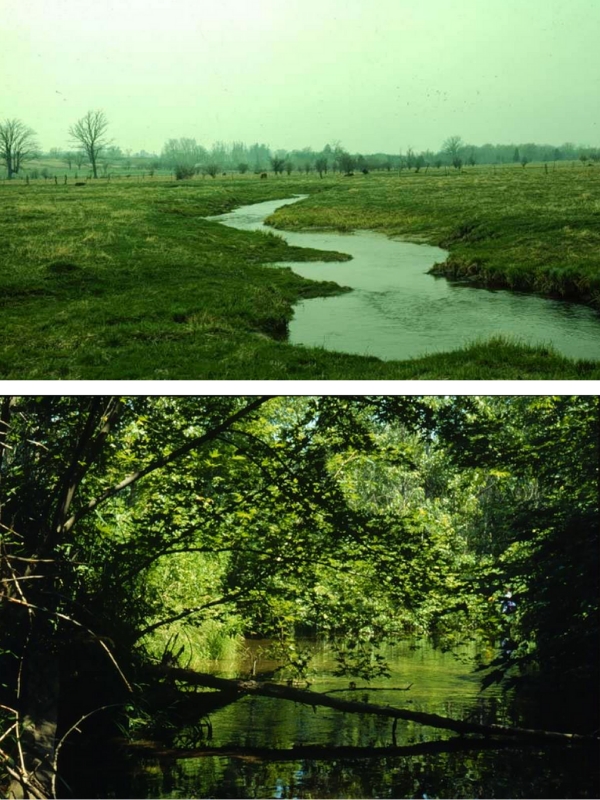
News
Buffer benefits
Planting a buffer reduces erosion and nutrient runoff.
May 10, 2019 By Stephanie Gordon
 Over the span of 15 years With the spotlight on surface runoff
Over the span of 15 years With the spotlight on surface runoffWith the spotlight on surface runoff, contractors can plant riparian buffers in addition to constructed wetlands to minimize environmental impact.
Research from Oxford County, ON, proves planting trees, grass and shrubs along a stream can help reduce erosion, decrease nutrient loss, increase wildlife and result in cleaner, cooler water. More trees can help convert farmland to be more “carbon-neutral” and protect crops from moderate flooding events.
Naresh Thevathasan, agroforestry specialist at the University of Guelph and co-author of the study, says nutrient loading was significantly reduced over the years after planting riparian buffers along the 5.5-mile stretch of Washington Creek. The team saw a more than 90 percent reduction in nitrates and phosphorus – elements singled out because they contribute directly to the eutrophication and algae bloom seen in Lake Erie.
Riparian buffers mainly address surface runoff, not runoff from tile drains. To benefit from riparian buffers, Thevathasan recommends creating an artificial wet zone for the tile to drain into, and then planting a riparian buffer between the wet zone and a stream. If an artificial wet zone isn’t possible, planting a riparian buffer will still help curb nutrient loading through surface runoff.
The Grand River Conservation Authority, a partner in the project, promotes planting perennial grasses, trees, and shrubs 9.8 feet from the bank, or 19.7 feet from the middle of the creek. For complete removal of nutrients, Thevathasan recommends 98.4 feet (30 meters) of buffer. “We know that is difficult to achieve because none of the landowners are going to sacrifice 30 meters of land, but my thumb rule is that any buffer is better than no buffer.”
Thevathasan says another misconception is that landowners will lose income if they allow land for buffers, but that’s not the case. The land used for riparian buffers can be used for diversifying income. Landowners can grow mushrooms, berry crops, or use the shade for ginseng; generating an income while, at the same time, contributing to water quality enhancement.
Trees contribute to a significant amount of carbon capture, so planting new trees is the same as removing cars off the road. Farms that plant riparian buffers can reduce their carbon footprint, or even become “carbon neutral.”
“If a landowner has 1,000 acres of land and his annual diesel consumption is 2,000 litres, we can calculate the carbon dioxide he will be emitting from 2,000 litres. If he has that amount of trees on his land, he’s carbon neutral because whatever he’s emitting is absorbed by the trees on his property,” Thevathasan explains.
For moderate flooding, riparian buffers can help prevent water from moving into uplands. Scientists from Iowa’s Centre for Global and Regional Environmental Research have found the frequency of extreme precipitation events are increasing, meaning that floods can become more common – a fact only too real for Iowa residents battling historic floods this spring.
“[A riparian buffer] acts the other way around,” Thevanthasan says.
“It is also a mechanism to control flooding from getting into the agricultural fields . . . [the buffer] reduces the energy of the water before it can hit the upland.” For drainage contractors, promoting the planting of a riparian buffer shows a commitment to water quality and nutrient runoff reduction.
The USDA National Agroforestry Center has many resources on riparian forest buffers, including a variety of buffer planning tools available online. The AgBufferBuilder is a tool that designs variable width buffers for water quality and helps design buffers with a targeted level of pollutant trapping efficiency. The Buffer$ tool estimates the costs and benefits of buffers compared to traditional cropping systems, including an analysis of what incentive programs are available. All of these tools and more are available online through www.fs.usda.gov/nac/practices/riparianforestbuffers.shtml.
Print this page